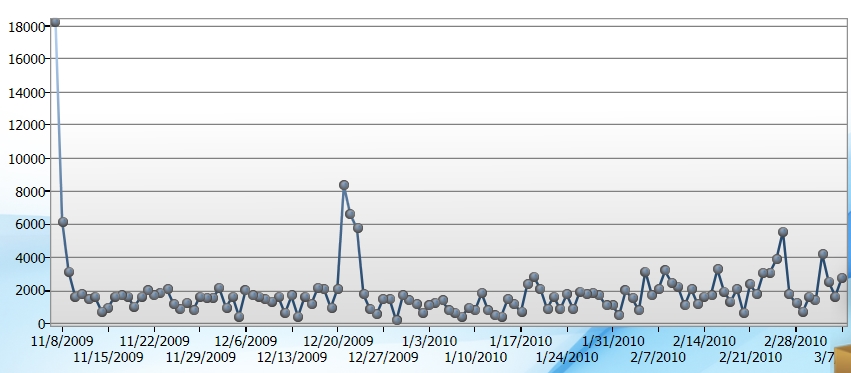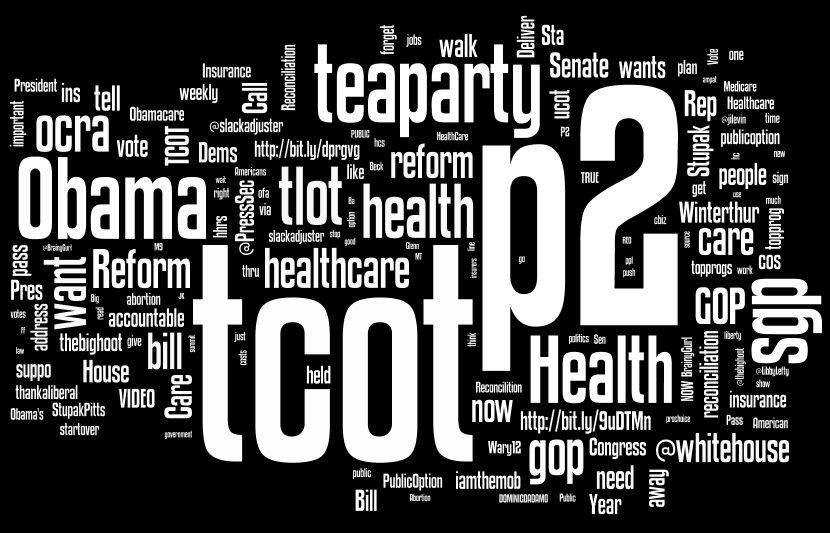
#HCR The Argument Joined
G. R. Boynton
#HCR has become the 'place to be' in the argument about health care reform. There are other hashtags used by people interested in the policy. Some are used predominantly by opponents and some primarily by supporters of change. But #HCR averages approximately 2,000 tweets a day with some upward movement in February and March as the end approaches. The figure below shows the number of messages per day. For the period of data collection there have been 216,838 messages using the hashtag #hcr.
Microblogging #HCR: Messages per day November 8, 2009 Through March 7, 2010 |
 |
The long process of passing the legislation is coming down to final votes. What is going on in the world of microblogging? As part of an answer to that question I will examine 3,107 tweets posted between 7:30 p.m. March 5 and 9:14 p.m. March 6, 2010. It is a day in the flow of communicating about health care reform.
The 140 character limit on a Twitter message puts substantial constraint on writing, and a number of conventions have developed to adapt to this limit. Hashtags, such as #HCR, are used to identify the conversation in which one hopes to be engaged, but they are also used to reference particular groups of individuals. Each of the messages included the #HCR hashtag, and many others are included in the messages. There are two ways to 'spread the word.' One is retweeting. The convention is quoting an individual by adding RT and the username of the person along with the text of the person's message; 1593 of these messages included the RT symbol. The second 'spread the word' is a reference to an external document. For this a url is included in the message; the urls are shortened so they will fit within the 140 character limit and 1727 of the messages included a url. A final convention is a procedure for referring to an individual. Instead of simply using the username a @ is added to the front of the username so there is no mistaking the reference; 1960 of the messages contained a @.
These numbers make it clear that this is not messaging into an internet 'black hole.' They are addressing, they are referring, they are entering a conversation. These references give us the ability to look at who is being addressed in the communication.
 |
It is called a word cloud. It is a visual representation of the words used in the messages. The more frequently a word is used the larger it is in the word cloud.
The largest are #p2 and #tcot; the # sign is dropped in the word cloud. 1138 messages refer to #p2, which is used to identify progressive tweeters. One can use the hashtag to identify with a group, but you can also use the hashtag to say I have something to say to #p2-ers with whom I disagree. So, the number should not be interpreted as one third of the messages are from progressives. #tcot is "top conservatives on twitter," and like #p2 can be used either to show one's own position or to indicate you have something to say to the conservatives. A count of the number of references to groupings can tell much about who is dominating the conversation.
Conservative designations |
Liberal designations |
||
| #tcot | 1104 | #p2 | 1138 |
| #teaparty | 392 | #tlot | 266 |
| #sgp | 342 | #dems | 292 |
| #gop | 316 | ||
| #ocra | 220 | ||
| #iamthemob | 80 | ||
| Total | 2454 | 1696 | |
#teaparty is the 'famous' teaparty group of conservatives. #sgp is smart girl politics which is also a conservative grouping. #gop the grand old party may not be conservative enough for many of those referencing the conservative side. #ocra is organized conservative resistance alliance. I particularly like #iamthemob which is self explanatory. Thinking of oneself as the mob seems remarkable to me, but then I am on the other side. Liberal designations include #p2, #tlot, which is top liberals on Twitter, and #dems for the democratic party.
The question is who is referenced -- being identified with and addressed? The conservatives have both more groups referenced and more references than the liberals. The argument is joined, but it is something of a one sided affair.
Who are the persons referenced in this communcation? Above everyone else is Obama with 618 mentions. And almost no one else. Glenn Beck is mentioned 89 times. Palin is mentioned 37 times, McCain 27, Pelosi 25, Reid, 13, and Romney 10 times. The surprise is Stupak with 279 mentions making him a distant second to Obama. He stands out at this point because of his leadership on not including abortion in the legislation.
This is remarkable de-personalized communication about politics. The only pattern is that Democrats Pelosi and Reid get many fewer mentions than do conservatives. Again the conservatives are dominating the references in the communication.
And to substantive content: health 863, reform 366, healthcare 286. After those it falls to references that appear in tiny fractions of the messages. Start over 154, insurance 151, reconciliation 148, abortion 130, public option 53, medicare 52, doctor 37, costs 40, and hospital 12. Words do not do a good job of capturing the 'content' of the messages. That will wait for another analysis.
The argument is joined, and the 'who' is easily identified in the communication. References to conservatives dominate this stream of messages. It reflects what is apparently the general pattern in politics at this moment. The conservatives are activated. The liberals are sitting on their hands.
© G. R. Boynton, 2010